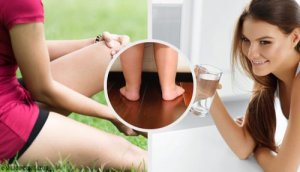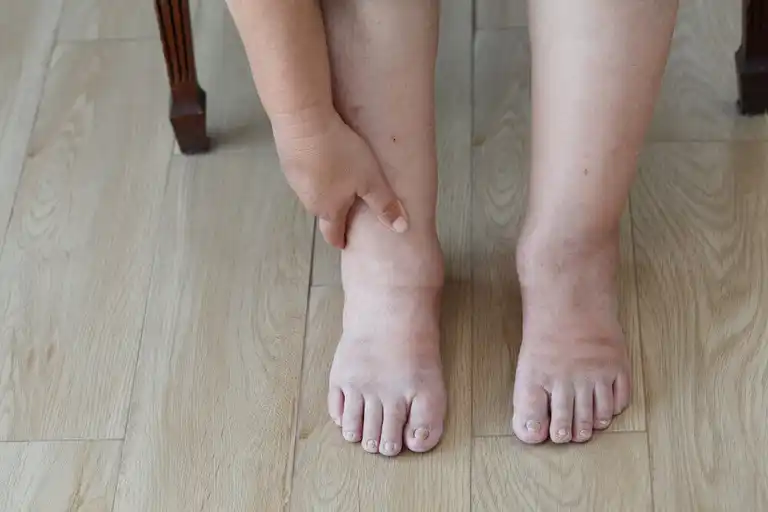Five Signs of Fluid Retention

Do you feel bloated? Have you put on weight for no apparent reason? If so, you might be suffering from fluid retention.
In this article, we’ll tell you some of the symptoms that suggest you might be retaining fluid. If this is the case, you should visit your doctor so they can prescribe the right treatment.
Fluid retention

Fluid retention, or edema, is a condition caused by an excessive accumulation of fluid in the tissues. When it’s pathological, it’s usually caused by circulatory problems, congestive heart failure, or kidney or liver diseases. On the other hand, if it’s not pathological, it might be attributed to a simple dilation of the veins when temperatures are higher.
The American Society of Clinical Oncology states that the main consequences of fluid retention include the following:
- Unexplained weight gain.
- Swelling in the legs and ankles.
- Increased abdominal perimeter or decreased need to urinate, among others.
Cases of edema usually occur in the elderly. However, adolescents have also been diagnosed with this condition.
The condition is more common in women than men, especially for hormonal or dietary reasons. In fact, it tends to appear during menopause or pregnancy. It can also occur in people with sedentary lifestyles.
In addition, fluid retention can be a sign that a person is suffering from another disorder. It could be a cardiac, renal, hepatic, or digestive problem. Therefore, it’s important to be alert and visit your doctor if you notice any of the following signs.
Five signs of fluid retention
1. Lower extremities
Your lower extremities are the first part of your body to be affected by fluid retention. Therefore, pay special attention to your legs and feet.
At first, you might feel tiredness and heaviness in your legs due to inadequate drainage.

Take a look at this article: How to Avoid Fluid Retention and Reduce Swelling
2. Thicker ankles
Edema, as the Mayo Clinic experts suggest, causes ankles to look thicker than normal. From when you wake up until you go to bed, this part of your body will increase in size as the hours go by.
3. Leg cramps
Going back to your legs, these will also swell (although sometimes people don’t notice it). However, one symptom that can reveal that you’re retaining fluid is experiencing frequent cramps in the area, along with weakness.
4. Bloating around your middle
Another area that’s affected by the signs of fluid retention is your belly. Some people think they’re gaining weight when, in fact, they’re bloated.
Some go on long, strict diets thinking that the increase in the size of their waist is fat. Nevertheless, in reality, it’s a failure of the excretory system. You might also retain fluid due to more serious illnesses, such as kidney or liver disease. For this reason, it’s essential to consult a doctor if you notice these symptoms.
5. Swelling of your face
The swelling that comes from edema can also happen on your face. It’s usually visible on your cheeks and eyelids, which slightly increase in size. The excess fluid makes your face appear rounder.
What to do if you think you’re suffering from fluid retention
The first thing you should do is go to the doctor to rule out anything serious. Also, if you think you’re retaining fluid, here are some useful tips that can help alleviate the symptoms.
You might also like to read: Natural Treatments for Fluid Retention
Drink more water
Although it may sound strange, when your body retains fluids, you need to hydrate it. This helps eliminate toxins and reduce fluid retention.
“The alteration of fluids and electrolytes in older adults occurs in most cases due to low water consumption. This alteration is exacerbated by decreased thirst, which generates a lower fluid intake and a renal tendency to less water retention.”
Restrepo S.L., Morales R.M., Ramirez M.C., López M.V., Varela L.E. (2006)

Exercise
Exercising will help you get rid of excess fluid through sweat and urine. It’ll also improve your circulation. Focus, above all, on your leg area and try to exercise for about 20 minutes each day.
Follow a balanced low sodium diet
The Spanish Heart Foundation suggests that, if you’re suffering from fluid retention, you limit your consumption of flour, fat, refined sugar, and, above all, salt.
- Drink diuretic teas. Certain plants will help you go to the bathroom more regularly. This helps you eliminate fluid.
- Add foods to your diet like carrot and cucumber. Also fruits like melon and watermelon.
- Eat foods high in potassium: Corn, cauliflower, bananas, and asparagus can help eliminate fluid retention due to their potassium content. In fact, deficiency in this mineral can lead to fluid retention so try and increase your consumption of it.
- Avoid alcohol, especially beer and spirits.
- Eat protein: Chicken, red meat, fish, shellfish, and legumes are all good options. However, a diet with too much protein will have the opposite effect. It’s best to follow a balanced diet.
Avoid unhealthy habits
Here are some more habits to avoid:
- Don’t wear tight clothing as it’ll make your body swell up more as the day goes on.
- Avoid a sedentary lifestyle. If you’re sitting at your desk all day, get up from your seat for at least five minutes every hour. If you do this, your body won’t enter a sedentary state.
- Stay away from too much heat. Stay away from environments that are too hot, since heat produces dehydration. When this happens, your body retains fluids. It also causes your veins to dilate which can make you retain fluid.
Now you know the symptoms and factors that cause fluid retention, try to avoid them. They’ll not only help you alleviate the problem, but also lead a healthier life.
All cited sources were thoroughly reviewed by our team to ensure their quality, reliability, currency, and validity. The bibliography of this article was considered reliable and of academic or scientific accuracy.
- Flores-Villegas B, Flores-Lazcano I, de Lourdes Lazcano-Mendoza M. Edema. Enfoque clínico. Medicina interna de México 2014; 30 (1): 51-55. Available at: http://www.medigraphic.com/cgi-bin/new/resumen.cgi?IDARTICULO=48337. Accessed 27/12, 2020.
- MedlinePlus. Edema. 2018. Available at: https://medlineplus.gov/spanish/edema.html. Accessed 27/12, 2o20.
- Restrepo SL, Morales RM, Ramírez MC, López MV, Varela LE. Los hábitos alimentarios en el adulto mayor y su relación con los procesos protectores y deteriorantes en salud. Revista chilena de nutrición 2006; 33 (3): 500-510. Available at: https://scielo.conicyt.cl/scielo.php?pid=S0717-75182006000500006&script=sci_arttext&tlng=pt. Accessed 27/12, 2020.
- Fundación Española del Corazón. Soluciona la retención de líquidos. https://fundaciondelcorazon.com/blog-impulso-vital/2649-soluciona-la-retencion-de-liquidos.html
- Sociedad Estadounidense de Oncológica Clínica. Retención de líquidos o Edema. https://www.cancer.net/es/asimilaci%C3%B3n-con-c%C3%A1ncer/efectos-f%C3%ADsicos-emocionales-y-sociales-del-c%C3%A1ncer/manejo-de-los-efectos-secundarios-f%C3%ADsicos/retenci%C3%B3n-de-l%C3%ADquidos-o-edema
This text is provided for informational purposes only and does not replace consultation with a professional. If in doubt, consult your specialist.








